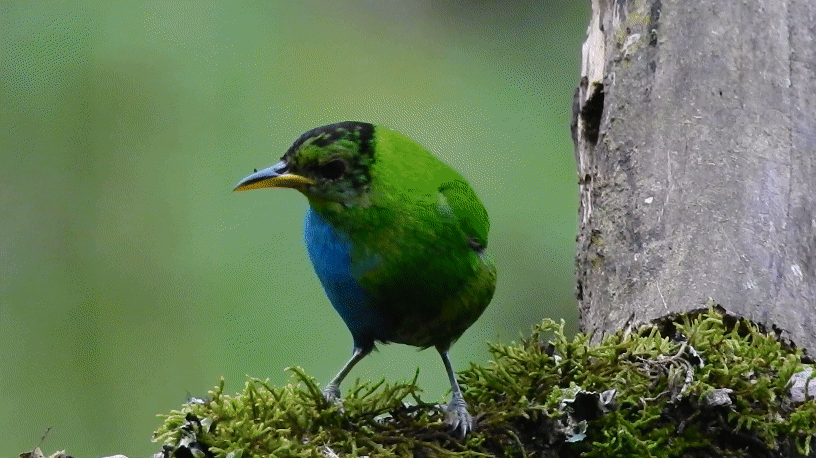Animals
Sharks Are Being Killed at Rising Rates Despite Increased Regulations
Global bans on finning have inadvertently opened up shark meat markets, prompting demand for threatened species, a new study reveals
Inside Elephant Seal Pups' Race to the Depths
While northern pups dive right in, their southern cousins take their time
What Caused the Mysterious Extinction of 'Giganto,' the World's Largest Ape?
The massive primates were unable to shift their diet to keep pace with a changing climate, according to a new study, forcing them to eat less nutritious bark and twigs
This 288-Million-Year-Old Fossilized Scrap of Skin Is the World's Oldest
The remains, found in an Oklahoma cave, belonged to a lizard-like reptile
Can Killing One Species of Owl Help Save Another?
Biologists and conservationists are grappling with a controversial plan to kill 470,000 barred owls in the Pacific Northwest over the next 30 years
See the 'Adorable'—and Deadly—Black-Footed Cat at a Utah Zoo
Eight-month-old Gaia is part of a breeding program for her vulnerable species, which is considered the "world's deadliest cat"
Early Primates May Have Feasted on Soft, Sweet Fruits
An analysis of more than 400 fossilized teeth suggests the creatures weren't eating many seeds, nuts or other hard foods
See 25 Breathtaking Images From the Wildlife Photographer of the Year Contest
Representing some of the world's best nature photography, the pictures are being put to a popular vote for the People's Choice Award
Meet 'Hercules,' the Largest Male Funnel-Web Spider Ever Found
Despite belonging to the most venomous arachnid species on Earth, the spider will be using his bite for good in a program to produce antivenom
Decades-Long Debate on 'Teenage' Tyrannosaur Fossils Takes Another Turn
A new paper adds to evidence suggesting a group of disputed fossils, identified by many scientists as young T. rex, are actually another species
The Top Ten Ocean Stories of 2023
Major discoveries, an undersea tragedy and international cooperation were some of the biggest saltwater moments of the year
Seven Scientific Discoveries From 2023 That Could Lead to New Inventions
Biologists learned lots about animals and plants this year, and their findings could inspire better robots, medicine and environmental technologies
Reindeer Sleep and Eat Simultaneously, Saving Precious Time in the Short Arctic Summer
While the animals chew their cud, they also enter a state of rest
Here's Why Most Dogs Have Brown Eyes
Humans may have bred their canine companions to have darker eyes, because we perceive them as younger and more friendly, study finds
Humans May Have Driven Twice as Many Bird Species to Extinction as Previously Thought
Statistical modeling of undiscovered extinctions suggests 1,430 bird species have disappeared during modern human history
The Ten Most Significant Science Stories of 2023
From an asteroid sample that was delivered to Earth to a discovery about human migration from North America, these were the biggest moments of the year
Chimpanzees and Bonobos May Remember Faces for More Than 20 Years
The great apes, which are humans' closest living relatives, appeared to recognize photos of their former acquaintances in a study, even decades later
How Seabirds Can Help Us Predict the Size of Fish Stocks
The scientists who study terns, puffins and other birds are trying to get fisheries managers to heed their warnings
Like Dogs, Some Cats Will Play Fetch—but Mostly on Their Own Terms
Many felines appear to pick up the playful behavior spontaneously, without any explicit training, a survey of cat owners finds
This 'Extremely Rare' Bird Is Half Female, Half Male
The green honeycreeper is only the second of its species ever observed with this condition—and the first recorded in more than 100 years
Page 7 of 179
:focal(2657x1784:2658x1785)/https://tf-cmsv2-smithsonianmag-media.s3.amazonaws.com/filer_public/22/10/22106a0d-150b-468f-ae61-05e6daf77320/gettyimages-1297383471.jpg)
:focal(800x602:801x603)/https://tf-cmsv2-smithsonianmag-media.s3.amazonaws.com/filer_public/4f/e3/4fe36870-9858-431c-bf62-904686192be7/gettyimages-1368708550_web.jpg)
:focal(1440x933:1441x934)/https://tf-cmsv2-smithsonianmag-media.s3.amazonaws.com/filer_public/fe/11/fe11489c-890c-4f3a-bdf3-cc0eff2913c5/the-extinction-of-the.jpg)
:focal(800x602:801x603)/https://tf-cmsv2-smithsonianmag-media.s3.amazonaws.com/filer_public/a1/30/a130b8ef-033f-4a49-8780-341693394317/fossilized-skin_credit-current-biology-mooney-et-al.jpg)
:focal(1254x836:1255x837)/https://tf-cmsv2-smithsonianmag-media.s3.amazonaws.com/filer_public/d9/70/d970872c-05ba-48f5-b889-40a2a3a6b6c4/gettyimages-1439040478.jpg)
:focal(1506x760:1507x761)/https://tf-cmsv2-smithsonianmag-media.s3.amazonaws.com/filer_public/43/f0/43f0ac0e-5e65-4b04-ad6f-074c50157ad4/img_7672.jpeg)
:focal(700x527:701x528)/https://tf-cmsv2-smithsonianmag-media.s3.amazonaws.com/filer_public/dc/de/dcde6ff1-e24d-4685-9dff-1368b7a66262/untitled_design.jpg)
:focal(640x427:641x428)/https://tf-cmsv2-smithsonianmag-media.s3.amazonaws.com/filer_public/4c/09/4c09c899-bdf5-4c8f-b2c8-dd9e0cb6cf8d/tzahi_finkelstein_wildlife_photographer_of_the_year.jpg)
:focal(541x614:542x615)/https://tf-cmsv2-smithsonianmag-media.s3.amazonaws.com/filer_public/eb/51/eb51a5d1-1a77-4ee0-8f59-9eadb11eafc5/spider.jpeg)
:focal(350x230:351x231)/https://tf-cmsv2-smithsonianmag-media.s3.amazonaws.com/filer_public/fd/0b/fd0b31c6-07df-4c2b-b236-0bf9409effe2/low-res_nanotyrannus_versus_baby_t_rex_reduced.jpg)
:focal(800x602:801x603)/https://tf-cmsv2-smithsonianmag-media.s3.amazonaws.com/filer_public/84/75/8475af37-08ad-4be0-8440-c1fafcdba98f/gettyimages-1783943875_web.jpg)
:focal(960x649:961x650)/https://tf-cmsv2-smithsonianmag-media.s3.amazonaws.com/filer_public/52/0c/520c1e9a-9a4e-4182-a0e6-2530427f0848/monarch-butterfly.jpg)
:focal(1831x1378:1832x1379)/https://tf-cmsv2-smithsonianmag-media.s3.amazonaws.com/filer_public/c2/ae/c2aeb441-2f24-4d7c-ab62-c2988306ce46/reindeer_credit_leo_rescia.jpeg)
:focal(1111x677:1112x678)/https://tf-cmsv2-smithsonianmag-media.s3.amazonaws.com/filer_public/4d/0c/4d0ca5df-da8c-452a-9bea-96613ed278b4/gettyimages-1125470365.jpg)
:focal(616x463:617x464)/https://tf-cmsv2-smithsonianmag-media.s3.amazonaws.com/filer_public/99/40/994052a2-a377-465d-b9e7-b4eb43bb6d57/ai-image-possible-extinctbirds3.jpg)
:focal(800x602:801x603)/https://tf-cmsv2-smithsonianmag-media.s3.amazonaws.com/filer_public/bc/1a/bc1a8ce0-a261-43a8-b66a-0a2dfed17308/topsciencestories2023-v3_web.jpg)
:focal(2880x1920:2881x1921)/https://tf-cmsv2-smithsonianmag-media.s3.amazonaws.com/filer_public/a6/29/a629229c-9782-4d21-b5d4-96310142e0d6/027a2815.jpeg)
:focal(800x602:801x603)/https://tf-cmsv2-smithsonianmag-media.s3.amazonaws.com/filer_public/c0/f2/c0f2697e-eb83-46fb-b165-4b09f22f5e91/header-uncropped_web.jpg)
:focal(960x640:961x641)/https://tf-cmsv2-smithsonianmag-media.s3.amazonaws.com/filer_public/9a/b5/9ab5d286-eef1-464f-a871-6dd72a48bc2a/cat-649164_1920.jpg)
